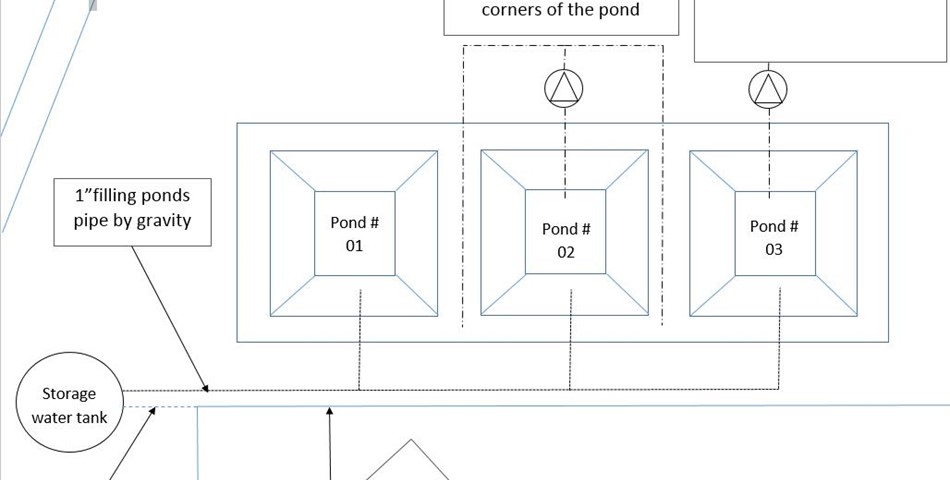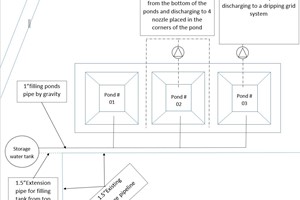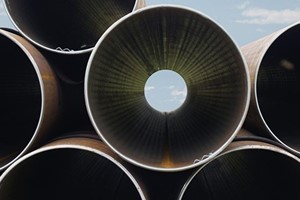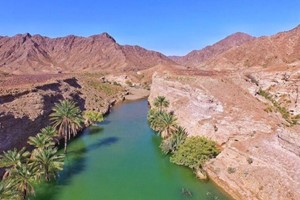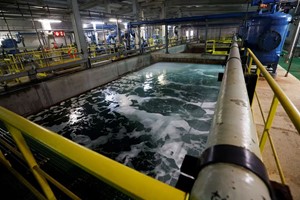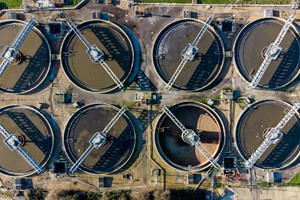In the last decade, reverse osmosis (RO) has grown as an alternative to traditional potable water sources. A major disadvantage of the RO process is the huge amount of reject brine and its negative impact as a result of its high salinity.
Further research is needed for introducing environmentally friendly and economically viable management options for RO brines. RO produces a clean stream of high purity water, and as well a smaller stream of waste, referred to as concentrate or brine. Brine is a highly concentrated solution of the salts and contaminants separated from the water with the reverse osmosis membranes. Brine requires proper disposal, which many times requires permits or other regulatory compliance actions. There are many brine disposal methods available today, which all have different environmental and capital costs.
The common brine disposals methods have their pros and cons. In Oman, due to the increased level of soil and water salinization along Al-Batinah region coast, an increasing number of farmers are using small-scale desalination units for producing irrigation water. Desalination technology remains still an expensive option for agriculture. In addition, it has environmental challenges that includes energy requirements, water quality, and disposal means of rejected brine which end up in many cases by contaminating their groundwater and increasing its salinity. However, it can still be an attractive option for sustainable agriculture if used within specific constraints.
Although technological advances have resulted in the development of new and highly efficient desalination processes, little improvements have been reported in the management and handling of the major by-product waste of most desalination plants, namely reject brine. Reject brine contains variable concentrations of different chemicals such as anti-scale additives and inorganic salts that could have negative impacts on soil and groundwater. By definition, brine is any water stream in a desalination process that has higher salinity than the feed.
The characteristics of reject brine depend on the type of feed water and type of desalination process. They also depend on the percent recovery as well as the chemical additives used (Ahmed et al., 2000). The disposal of desalination brine (concentrate) represents major environmental challenges to most plants, and it is becoming more costly. Brine disposal costs are high today, between 5 and 33 percent of total desalination cost (Ahmed et al. 2001), complicating implementation. This cost depends on the quality of the concentrate, treatment level before disposal, disposal method and the volume or quantity of concentrate. Disposal costs for inland desalination plants are even higher than those for plants discharging brine into the sea (Arnal et al. 2005).
In spite of the scale of this economic and environmental problem, the options for brine management for inland plants have been rather limited (Ahmed et al., 2001). These options include: discharge to surface water bodies or wastewater treatment plants; ponds, concentration into solid salts and irrigation of plants tolerant to high salinity; deep well injection; land disposal; evaporation ponds; and mechanical/thermal evaporation.
To help farmers in Oman deal with the challenge of brine management, MEDRC joined efforts with Sultan Qaboos University (SQU) researchers to carry out an innovative research project on evaporation enhancement that would include: 1) A comprehensive literature review on the topic of evaporation enhancement and identification of most promising ones for field situations; 2) Perform laboratory experiments under controlled conditions and field experiments with the most promising evaporation methods; and 3) Perform cost-benefit analysis of the selected methods and prepare design criteria and guidelines for practical applications.
This project aims to assist and train Oman Farmers in adopting such methods. MEDRC goal is to enable operators of small-scale desalination plants for agriculture: 1) Reduce the impact of brine discharge on the environment, 2) Protect their crops, and 3) Reduce operation costs.
Desalination for agriculture in Oman
With increasing concerns about water scarcity in Oman and the whole Gulf region, agriculture is under pressure to improve water management and explore available options to match supply and demand. In Oman, Al-Batinah coastal plain is by far the most important agricultural area located between the Hajar mountain ranges and the Gulf of Oman. Over-pumping of water in recent years has led to an alarming advance of sea water intrusion and increased salinity of groundwater. As a result, some agricultural lands of the coastal areas have become unsuitable for cultivation. Desalination remains an excellent technical option to increase the availability of freshwater both in coastal areas with limited resources and in areas where brackish waters - such as saline groundwater, drainage water and treated wastewater - are available.
Greenhouse and hydroponic farmers are beginning to use RO to desalinate and purify irrigation water for greenhouse use (the RO product water tends to be lower in bacteria and nematodes, which also helps to control plant diseases). Small RO plants have been built in rural areas where there is no other water supply option. An increasing number of Omani farmers are changing the irrigation water supply from a contaminated surface water canal source to an RO-desalinated brackish groundwater source.
The huge amount of brine represents a negative impact as a result of its high salinity. This brine is usually discharged not far from the farms using RO systems, and end up by contaminating ground waters and increasing salinity. Failure to address this negative impact will impact the sustainability of agriculture activities and consequently the incomes of the farmers as well. Most of inland desalination plants (80 percent) in Oman are RO type of small capacities (below 10.000 m3 per day). More than 50 percent are desalinating brackish water or inland water (TDS 3000ppm - <20000ppm). (Table 1, GWI 2016)
Solar Evaporation ponds
Evaporation ponds are especially suitable to dispose of reject brine from inland desalination plants in add and semi-arid areas due to the abundance of solar energy. In irrigation projects facing a soil salinity problem due to a shallow saline groundwater table, evaporation ponds are also in use. Saline water tables are lowered by pumping or tile draining and the drainage water is stored in evaporation ponds. While evaporation ponds have long been used for salt production in many parts of the world, the disposal of concentrate from desalination plants in inland areas using evaporation ponds is of much significance both economically and environmentally. Guidelines are needed for their design, construction, maintenance, and operation for reject brine disposal in an economical and environmentally-sensitive manner. Solar evaporation consists of leaving brine in shallow evaporation ponds, where water evaporates naturally thanks to the sun's energy. Salt is left in the evaporation ponds or is taken out for disposal (Katzir et al. 2010). The size of the evaporation pond is a function of the rate at which reject brine is evaporated from the ponds. Different methods of calculating evaporation rates are available. If it were possible to increase/enhance the natural evaporation rate, it would be possible to reduce the size of the evaporation ponds. Such a reduction would result in substantial savings in the construction costs of ponds. The design of an evaporation pond depends critically upon knowledge of the spatial and temporal distribution of net evaporation rates and of the evaporative characteristics of the brine.
Evaporation Ponds Experiments
Evaporation ponds for disposal of concentrate from desalination plants need to be constructed as per the design and maintained and operated properly so as not to create any environmental problem, especially with regard to groundwater pollution. Liners are the most important feature of an evaporation pond and one of the major components in the construction cost. They should be impermeable to avoid brine leakages and mechanically strong to withstand stress during salt cleaning (Ahmed et al. 2000). The use of clay liners with low permeability will substantially reduce the cost of construction, although a small number of leakages are to be expected.
The idea was to construct three evaporation ponds, one as reference pond, and a second one equipped by sprinkles and spray system and a third one equipped by a dripping grid system to improve the evaporation rate. We put a storage tank for reject brine, which comes from MEDRC RO Pilot Plant. MEDRC RO Pilot Plant is a two pass plant with a production capacity of 3 m3/h. It has been specially designed to fit with hands on training needs in operation, monitoring and troubleshooting. The brine stored at the tank and pumped in the evaporation ponds has a salinity value of salinity conditions 30,000 ppm.
We are using a weather station equipped with all necessary sensors to get: daily weather parameters (air and water-surface temperatures, relative humidity, wind speed, incoming long- and short-wave radiations, albedo), and we calculate daily evaporation from ponds (predicted versus measured), and variables such as: EC of pond water, spray rate, pond depth, pond brine temperature. Since the early 2000s, MEDRC has conducted several research projects dealing with such issue, and we have gained substantial knowledge base in regard to the potential use of evaporation ponds. However, in practice this knowledge has not been transmitted to the end users and farmers particularly. MEDRC has now built evaporation ponds at its facilities (to be further implemented by adding solar stills), and this will help bringing up the farmers and deliver a hands-on training.
Finally, we will prepare guidelines for practical applications 'brine management guidebook', which will explicitly link different brine management options (disposal and beneficial uses) with ecosystem responses and ecosystem services, with a view that this may feed into more site specific cases related to agricultural activities in Oman. A soil salinity mapping will be carried out to prepare cost-effective salinity alleviation measures (e.g. Al-Batinah region). This research would help promoting the concept of evaporation ponds as a possible solution to the problem of brine in Omani farms.




